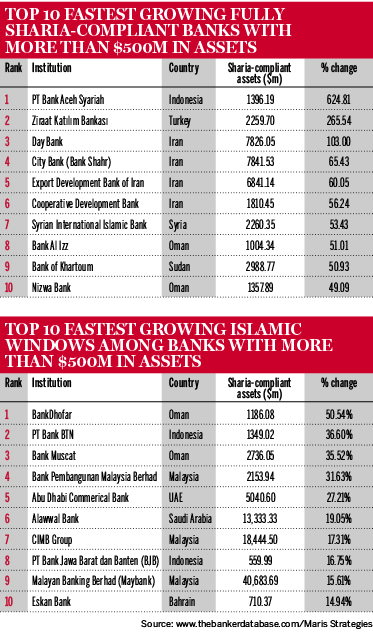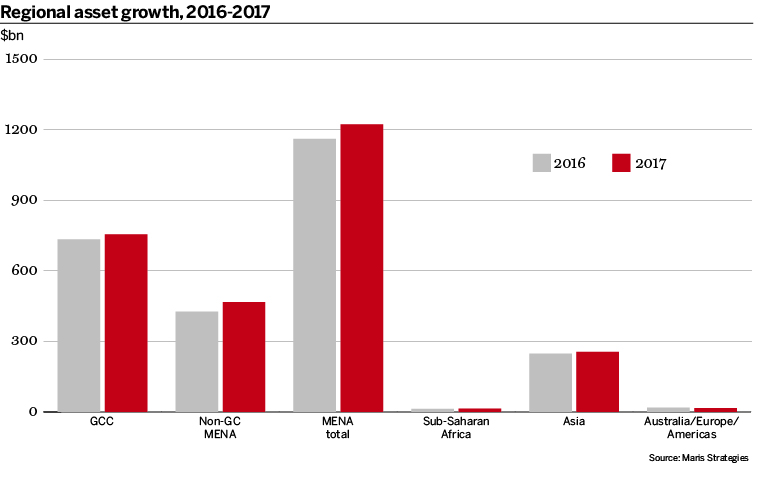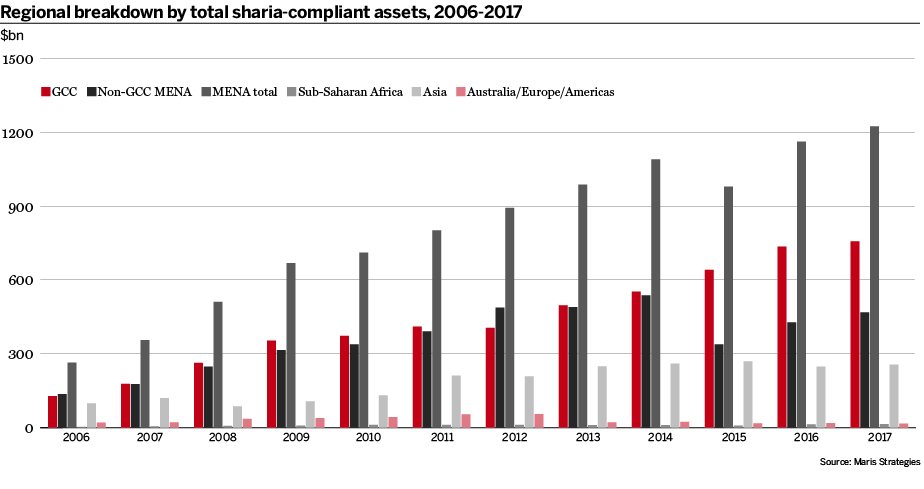The Banker's Top Islamic Financial Institutions – 2017
This year’s top Islamic financial institutions ranking shows better performances across the board, with less developed markets showing the most significant growth, and Africa seen as a prime market for expansion. James King reports.
The Banker’s 2017 Top Islamic Financial Institutions ranking should give the industry cause for cheer. By most indicators, sharia-compliant institutions have significantly improved on their performance in 2016’s edition. Encouragingly, the most impressive growth stories have emerged from the industry’s less developed regions, including sub-Saharan Africa and the non-Gulf Cooperation Council (non-GCC) Middle East.
More from this report
Nevertheless, even in the more mature markets, growth has ticked along at a respectable pace. This strong market-wide performance is likely a reflection of Islamic institutions adapting to more difficult market conditions, coupled with marginally improving oil prices over the review period.
Total sharia-compliant assets grew by 4.74% in this year’s ranking, reaching $1509bn. This average growth rate was bettered by sub-Saharan Africa, which recorded a year-on-year increase in assets of 7.18%, while in the non-GCC Middle East and north Africa it was even more impressive at 9.45%. In Asia, total assets increased by 3% in the 2017 ranking, while the GCC was not far behind on 2.92%. Elsewhere, total sharia-compliant assets in Australia, Europe and the US fell by 11.1% over the period.
A strong Oman
Over a longer timescale, this asset growth story is even more revealing. Between the 2006 and 2017 Top Islamic Financial Institutions rankings, the global compound annual growth rate (CAGR) for sharia-compliant assets was 12.04%. Over the same period, the Middle East and north Africa (including the GCC) outperformed the global average with a CAGR of 13.63%. Sub-Saharan Africa achieved the same feat, posting a CAGR of 13.65%. Asia, meanwhile, registered a CAGR of 8.25%.
In the 2017 edition, Oman has emerged as a standout market for asset growth. Two of the country's fully sharia-compliant lenders are in the top 10 banks by asset growth (with more than $500m in assets), while a further two institutions are included in the equivalent ranking for the ‘Islamic windows’ of conventional banks. This performance follows truly impressive gains made by Islamic institutions over the 2016 review period.
According to data from the Central Bank of Oman, between February 2015 and February 2016 Islamic institutions increased their share of the banking system’s total assets from 5.1% to 10.8%. Much of this growth stemmed from newer fully sharia-compliant lenders, including Nizwa Bank and Alizz Islamic Bank, which have overcome several developmental challenges to post stellar growth figures over the past couple of years.
Indonesia realising potential?
Elsewhere, Indonesia made a strong showing in the asset growth stakes. PT Bank Aceh Syariah topped the list of fully sharia-compliant institutions with a 624% increase in assets over the review period. This stratospheric performance was down to Bank Aceh’s conversion into a fully Islamic entity, becoming PT Bank Aceh Syariah. Meanwhile, PT Bank BTN, a window, reached second place in the equivalent table with asset growth of 36%.
Indonesia’s potential as an Islamic finance market has been noted for some time. Malaysian banks, for instance, have been quick to establish footholds in this market of 250 million mostly underserved consumers. According to Indonesia’s financial services authority, Islamic institutions secured a 5% share of the banking market’s total assets by September 2016. In total, the country’s mix of Islamic banks, both full windows and fully sharia-compliant entities, posted asset growth just shy of 12% in 2016. In the coming years, this figure is expected to be the annual growth norm as the Indonesian authorities work towards a target of 15% of total banking sector assets being sharia compliant by 2023.
Rounding up the 2017 Top Islamic Financial Institutions ranking by asset growth, out of the 375 institutions featured, 44 had assets of $10bn or more, marking an increase on the 43 featured in last year’s edition. Meanwhile, 89 banks registered between $1bn and $10bn in assets this year compared with 81 in the 2016 ranking. At the lower end of the asset size spectrum, 151 institutions had assets of between $100m and $1bn, an increase from the 144 last year, while 91 entities had assets of less than $100m.
Better profitability
Beyond asset growth, the profitability of Islamic financial institutions has also improved. This year, the average return on assets (ROA) for standalone sharia-compliant lenders was 1.29%, up from 1.26% in the 2016 edition. This incremental improvement comes as many banks and financial institutions in oil-dependent economies have adjusted to more challenging operating conditions through measures to improve their cost-to-income ratios, while placing additional emphasis on aspects of their businesses that are less aligned with the oil sector. In total, the profits of standalone sharia-compliant banks hit $14.88bn, up from $13.68bn in last year’s ranking.
Assessing the top 10 commercial banks by ROA, with profits of $100m or greater, is also revealing. The jurisdictions featuring this year are starkly different to the 2016 ranking, providing further evidence that the industry’s less mature markets are slowly coming to the fore. While three GCC banks made the 2016 list, only one, Bahrain’s Gulf Finance House (GFH), did so in 2017. Scooping the top spot with an ROA of 7.83% and a 1841% increase in pre-tax profits, GFH also stormed the profitability rankings in the 2017 Top 100 Arab Banks ranking. This performance was attributable partly to significant recoveries the group made over the review period.
Nevertheless, the GCC has, on the whole, posted respectable numbers. Profitability among the region’s largest Islamic lenders has remained buoyant, even if lenders from less developed markets have posted better numbers. Saudi Arabia’s Al Rajhi Bank, for instance, the largest sharia-compliant institution in the world, saw its net profits increase by just short of 14% over the review period. Dubai Islamic Bank and Qatar Islamic Bank saw their profits increase by 5.6% and 3.9%, respectively. Kuwait’s Boubyan Bank has recorded one of the highest net profit increases in the region with 17.3% growth in 2016.
Reaching parity
Robust asset and profitability growth, despite the challenges in the global economy, cast a positive light on the performance of most Islamic institutions in this year’s ranking. But beneath this wider performance a number of longer term trends have emerged. For one, the performance of Islamic institutions in the most advanced markets appear to have reached parity with their conventional counterparts.
After several years of moderating growth, Islamic lenders in Malaysia, for instance, are now posting numbers expected from mature financial institutions. This plays some part in accounting for the Asia region’s below-average annual asset growth of just over 3%, given the disproportionate contribution of Malaysian banks’ assets to Asia as a whole.
The same forces are at work in the Middle East and north Africa. Excluding the GCC, the region enjoyed asset growth of 9.45%, well above the performance of their GCC counterparts’ at 2.92%. Though macroeconomic differences between oil exporters and importers have played a role in this distinction, there is more to the story. The GCC’s Islamic banks are, like their Malaysian peers, relatively mature. Growth trajectories on the whole have been moderating for some years now and have, in many cases, reached parity with conventional peers. Exceptions exist, however, with the likes of Al Rajhi Bank and Boubyan Bank massively outperforming regional market averages.
But on the whole, the region’s less developed Islamic finance markets have performed particularly well. Algeria’s Al Salam Bank, for instance, registered asset growth of 30% over the review period. Institutions in Palestine, Syria and Jordan also posted strong numbers in this year’s ranking. Many of these markets are starting from a low base in terms of the penetration of Islamic financial services and as such are reaping the benefits of tapping into relatively underserved populations. As education and awareness around Islamic finance in these jurisdictions increases, these growth stories can expect to continue in the coming years.
African stars
The performance of institutions in sub-Saharan Africa has been equally impressive in the 2017 ranking: the region as a whole registered asset growth of just over 7%. Since 2006, the region has only been outperformed by the GCC in terms of its CAGR, which is 13.6%. In Nigeria, which is emerging as one of the most promising markets in Islamic finance, Jaiz Bank grew its assets by 28.4% in 2016. Amana Bank in Tanzania also performed well with annual asset growth of 14%. In Ethiopia, meanwhile, Oromia International Bank grew its sharia-compliant assets by 91%.
Africa’s stellar growth numbers will not surprise seasoned observers of the Islamic finance market. For some time now, private institutions, international regulators, training agencies and various experts have been turning their attention to the continent as one of the industry’s brightest growth prospects.
Though it only accounts for about 2% of the Islamic finance market’s total assets, according to some estimates, it nevertheless boasts a Muslim population of about 250 million. Some African states are now looking to capitalise on the benefits of embracing Islamic finance, with sovereign sukuk (Islamic bond) transactions becoming relatively commonplace. South Africa, Senegal and Côte d’Ivoire have all tapped the market in recent years.
Kenya, in particular, is pushing hard to position Nairobi as a regional hub for Islamic finance. In late 2016, the country’s Capital Markets Authority obtained associate membership status of the Malaysia-based Council of the Islamic Financial Services Board (IFSB). In its latest 2017/18 budget, the government unveiled reforms designed to promote Islamic financial services in the country, including changes to stamp duty and value-added tax, to level the playing field between conventional and Islamic lenders. In addition, the authorities have implemented the appropriate structures to permit sovereign and corporate sukuk issuance in the country.
Meanwhile, in January 2017, the Africa Finance Corporation issued its first $150m sukuk, which was seen as a milestone transaction for the industry’s development on the continent. The transaction will be used to support infrastructure development across Africa. Indeed, the use of sukuk to fund infrastructure projects is increasingly being seen as a good fit for emerging economies around the world. Rating agency Standard & Poor’s has argued that sukuk transactions could play an appreciable role in meeting the UN’s Sustainable Development Goals. Encouragingly, governments in Africa are seeing the benefits. Nigeria issued its first sovereign sukuk, at a value of $326m on the local market, in September 2017 to fund road infrastructure.
Familiar hurdles
Nevertheless, the obvious benefits that Islamic finance can bring to emerging economies will not be free from challenges; for one, establishing the right regulatory and legal frameworks in which sharia-compliant products and services can be conducted. Sovereigns looking to tap the sukuk market, for instance, take many years to prepare for an inaugural transaction. Similarly, addressing the tax implications of Islamic banking can be an onerous process for a market that is engaging with the market for the first time. Making the right changes requires time and expertise.
But other more pressing challenges are also facing the industry’s development. The case of Emirati energy company Dana Gas is a good example. Following the issuance of a $700m sukuk in 2013, the company is now contesting its repayment of the instrument, arguing that it is no longer sharia compliant. The case, which is being heard in London’s High Court, is problematic for the industry as a whole because it presents a scenario whereby other sukuk issuers could refuse to meet their obligations based on changes to Islamic law over time.
Ironing out these kind of legal and operational uncertainties will be vital if the industry is to maintain its future growth momentum. A number of international bodies, including the Islamic Liquidity Management Corporation and the IFSB, are working on issues of standardisation and harmonisation to better integrate the industry.
Over the longer term, this should help to create a more cohesive, globally connected market that observes common professional standards. This should make it far easier for frontier markets to adopt sharia-compliant financial products, services and instruments, to promote economic growth.
For now, however, the industry continues to march in the right direction. Solid growth numbers in mature markets, including Malaysia and the United Arab Emirates, are being supplemented by stellar growth in newer jurisdictions. As such, growth opportunities still abound for those Islamic institutions with the risk appetite to shoot for new markets. If Islamic institutions performed well in the 2017 ranking, expect more of the same, or even better, next year.





